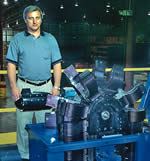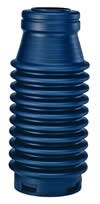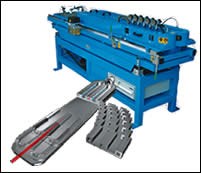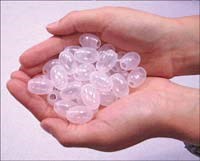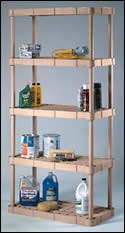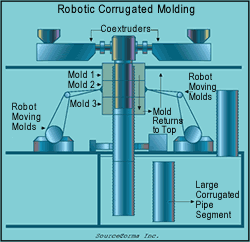'Corrugator Vacuum Forming'
Molding separate hollow parts on a pipe corrugator is a home-grown technique used by a small number of processors. They discovered it offers higher outputs and numerous other advantages over blow molding for making tube-shaped, precision medical, automotive, and appliance parts. But the process has not yet realized what could be its greatest potential in closed-end parts like bottles.
It sounds like a great idea: Continuously extrude a chain of hollow parts using special tooling on a pipe corrugator. Then just cut them apart. According to the handful of firms that have tried it, corrugator forming of automotive, appliance, and medical parts gets 30% to 50% more output than a shuttle blow molder with the same size extruder. They say there's also little or no flash and more uniform wall thickness than with blow molding. Tool changes and start-ups are faster. And the process is more flexible in terms of usable resins and ability to make different products simultaneously. So why aren't more people doing it?
One reason is that you can't exactly buy the technology off the shelf. Although nearly any corrugator could be adapted to the process, critical tooling and downstream trimming technologies are processors' own proprietary developments.
Corrugator vacuum forming of discrete parts is known to be practiced by only a few dozen processors globally. But the true number could be larger, since parts can be formed on conventional pipe corrugators with virtually no modification except different molds.
The process doesn't even have an "official" name, though users often call it just "vac forming." The technology is largely in the public domain because the process is identical to the way corrugated pipe sections are made with a bell molded on one end. The technology goes back at least to the 1970s for parts like corrugated hoses with smooth sections.
Standard pipe corrugation uses a continuous chain of mold blocks mounted on one or two oval tracks to vacuum form a continuously extruded tube or parison. It's not that different in concept from a wheel blow molder—except for the use of vacuum instead of positive air pressure (though sometimes air pressure is used as an assist on larger parts).
More uniform walls
According to those who know, corrugator forming of parts has several advantages over blow molding. Start-up time reportedly is faster on a corrugator than a blow molder—5 or 10 min. vs. half an hour or more. A corrugator generates almost no flash, while blow molding generates a lot. Wall distribution is much more even on a corrugator because parts are vacuum formed, not inflated, say advocates of the process. Blowing a profile against a mold reportedly thins the walls in the ridges, exactly where more material is needed.
Corrugator forming today is used primarily on tube-shaped parts that require different dimensions on the ends. Advocates say there's much larger potential in closed-end parts like bottles. But a corrugator still cannot match the productivity of a wheel blow molder. A corrugator molds roughly 30% fewer parts per hour and, at least by one measure, it makes less efficient use of its many molds. Corrugator molds are only in contact with plastic 40% of the time. Wheel blow molds contact plastic at least 70% of the time.
Make a family of parts
Advocates also say that corrugator forming can make hollow parts from lower-melt-strength resins that couldn't be used in conventional blow molding. A corrugator also can produce different parts in sequence during the same run, but they must have similar diameter and wall thickness.
Corrugator forming is also an efficient way to make a given product in a variety of different lengths. For example, Global Med Inc. in Trenton, Ont., molds corrugated medical tubing for respirators and anesthesia delivery, mostly in lengths of 40 to 72 in. But Global Med also makes tubes as short as 6 in. and as long as 120 in. Changing product length on the corrugator just requires switching the position of one pair of mold blocks that form the ends of the tube. That takes 15 to 20 min, says Global Med.
Automotive wire harness is another application where corrugators produce a family of parts of different lengths. Corma says it has sold over 100 corrugators in the U.S. and over 30 in Japan to vacuum form automotive wire harnesses. Corma, Unicor and Olmas Plastics Machinery in Italy (represented here by Summit Machinery Sales) all offer dual-strand corrugators, which can increase output.
It started with hoses
OEM Miller in Aurora, Ohio, has specialized for nearly 30 years in forming parts on corrugators. Its first part was a corrugated drain hose for a GE washing machine in 1978. The firm replaced injection molded nozzles and hose clamps by inserting mold blocks to form clamps and nozzles at the ends of the parts. Beginning around the same time, corrugated vacuum cleaner hoses were molded with smooth ends by Flexaust Co. in El Paso, Texas.
Corrugator applications for other hose-like products with formed ends are growing. Two years ago, Baxter Healthcare bought a pair of dual-strand Corma corrugators to make respirator tubes in Costa Rica. Hegler Plastic GmbH in Germany, which makes small horizontal corrugators, has sold about 10 systems in the past eight years for tubing with differentiated ends.
Progress from hoses to other corrugator-formed parts took a decade. OEM Miller vacuum formed its first non-hose part on a corrugator in 1989. It was an oval air duct for Chrysler, made on a Corma corrugator.
ABC Group, an automotive and industrial blow molder in North York, Ont., also commercialized its first corrugator-formed part in 1989—a small ribbed, bell-shaped dust cover for shock absorbers, made on a Cullum corrugator. ABC also commercialized an automotive air duct on a corrugator in 1998.
Corrugator forming of parts has grown steadily, if quietly, ever since—primarily for appliance, automotive, medical applications and even disposables like drinking straws. Automotive parts include boots for brakes, struts, and shock absorbers; dust covers for steering columns; air ducts; and fuel, vent, and vapor tubes. OEM Miller runs 24/7 production of parts on corrugators from Olmas and Cullom.
Tokico (USA) Inc. in Berea, Ky., a maker of struts and shock absorbers, became a corrugator former by default. Tokico originally bought corrugator-formed covers for shock absorbers from Hahn Elastomer. When that firm went bankrupt and closed a year ago, Tokico bought the corrugator machine and began making the parts itself.
Competitive pressures have pushed some blow molders to learn corrugation forming. Four years ago Omico Plastics Inc., an automotive blow molder in Owensboro, Ky., bought a Cullom vertical corrugator to make a Santoprene TPV boot for Delphi Automotive. Omico required three parallel trimming stations to keep pace with the corrugator. Omico gets 18 parts/min from the corrugator vs. 12/min from a six-cavity blow molder that it had used to mold boots. And the corrugator makes better parts. "Chances of wall-thickness variation in six-cavity blow molding are exponentially greater," notes senior v.p. Roger Evans. "With vac-formed parts, you don't get cavity-to-cavity variation."
Omico's corrugator was the last one Cullom built. Cullom's assets and corrugation machine designs were purchased in 2003 by Modern Machine Corp., a builder of downstream equipment. Meanwhile, HPM hired the designers of Cullum's corrugation forming equipment and planned to develop its own machine for high-volume applications like cups, bowls, and form-fill-seal containers. But HPM dropped its Continuous Vacuum Forming project before it even got to the prototype stage.
On the other hand, this new market has enough potential to attract other machine builders. Five years ago, Unicor GmbH in Germany (represented here by ProfilePipe) developed what is probably the only corrugator intended specifically for technical parts. It's called the Vario model UC 58 and has a patented sliding base to vary the length of the mold tracks. Closed chain length varies between 525 and 1900 mm and can hold between 40 and 90 small mold blocks. Unicor has sold 25 Vario models and about 10 other corrugators to make discrete parts.
Not a simple process
Corrugators are more complicated to keep running than blow molders. A cautionary case is that of Rubbermaid Home Products in Fairlawn, Ohio. It developed snap-fit PP risers for a system of industrial shelving on a corrugator. Rubbermaid bought a Cullom corrugator in 2002 and worked on the process for a year and a half. The R&D team overcame initial problems of warpage and ovalization of the circular profiles, but the production plant in Winfield, Kan., never managed to make good parts consistently. The machine was eventually shut down and sold off.
Most parts are now formed on horizontal corrugators, though vertical corrugators have some advantages. A vertical corrugator doesn't have to extend the die between the mold blocks.
Vacuum forming of parts requires some air inside the part so that atmospheric pressure can push the part against the mold. In tube-shaped parts, air is typically admitted via a needle in the die. For closed-end parts, the needle is in the mold block and it punctures the parison as the blocks close.
Tooling cost for corrugators is high because they use so many molds. Olmas, for example, offers horizontal corrugators that use from 60 to 120 pairs of mold halves. Omico's Cullom corrugator, which is making dust covers for automotive brakes, carries molds for 14 parts. Each part requires three pairs of molds, for a total of 42 pairs.
European corrugators (from Drossbach, Hegler, Olmas, and Unicor) typically use water-cooled molds, while North American models are commonly air-cooled, though Corma offers both air and water systems.
Tooling also puts practical limitations on part design. Corrugator-formed parts have to be straight, since the mold blocks move in a straight line.
Tool changing on a corrugator—despite the large number of tools—is quicker than for blow molding, says Omico's Evans. Omico can change the entire loop of 42 molds in only 30 min because the corrugator is a vertical type and uses book-style molds. Book molds hinge on one side, and both mold halves can be attached to the track with a single pin. Horizontal corrugators require removing each mold half individually, which takes longer.
The most difficult part of corrugator forming is cutting the parts apart. Trimming technology for corrugator-formed parts is typically developed by processors, not ma chinery OEMs, and is often proprietary or patented. Yama ichi Co. in Japan, for example, patented high-speed, precision trimming of small, hollow balls of soft elastomer-modified LDPE. The balls are 0.375 and 0.75 in. in diam.—one corrugator rib wide—and are used for pillow stuffing, so there can be no rough cuts. They are made on eight small dual-strand corrugators from Corma. Yamaichi offers its technology for license.
Trying hollow containers
The big untapped potential for corrugation forming is closed-end parts. They must be molded on a vertical corrugator because it allows the extruded profile to drop directly into the tooling.
Rubbermaid's development team ran trials of closed-end parts—long, flat panels for sheds, hollow table legs, and scaled-down models of garbage pails only 3 in. in diam. "There's no doubt that you can produce hollow containers of any size on a corrugator," says Gregory Floyd, formerly Rubbermaid's manager of technology development. Rubbermaid has applied for patents for molding closed-end parts on a corrugator.
OEM Miller also ran trials of closed-end parts. "There's a lot of potential for other parts that should gravitate to a corrugator," notes Wayne Heverly, v.p of sales and design engineering at Holm Industries, parent company of OEM Miller.
Omico's Evans agrees. His firm has considered vacuum forming bottles and other containers. At least one large bottle maker has tried molding gallon handleware bottles on a corrugator.
There are two good reasons that corrugators have not yet seriously challenged blow molding for closed-end parts: The productivity of corrugators can challenge shuttle blow molders but not wheel machines. And then there is the high cost of multiple molds.
Shuttle-type corrugators offer a potential solution to the tooling issue, especially for larger parts. They move a small number of molds back and forth on rails. Corma, Unicor, Drossbach, and Modern Machinery all offer shuttle-type corrugators, but so far the tooling moves too slowly.
"A fast-advancing mold principle is needed so that more molds are in contact with the plastic to get higher output," notes ProfilePipe president Tony Kime. "You also have to get your mold cost down, or the return on investment for large parts doesn't work."
Corma is developing a variant of a shuttle corrugator with four mold sections lined up vertically. Robots insert empty mold halves at the top. Mold sections then travel from top to bottom, and each mold half has its own robot to remove and reinsert it.
Related Content
Advanced Plastomers for Production of PE-Based Sealant Resins
Nova Chemicals’ new Astute products are suitable for a broad range of applications including food packaging, heavy-duty sacks and e-commerce.
Read MoreTPEs Meets NSF 51 Regulation for Commercial Food Equipment
Kraiburg’s new TPE series aimed at seals/gaskets, valves, flexible connectors, food contact hoses, and more.
Read MoreKraiburg TPE Expands Range of TPEs with ISCC PLUS Certification
The expanded range supports customers in the consumer and medical sectors in next steps toward a circular economy.
Read MoreTracing the History of Polymeric Materials -- Part 30: Polyurethane
In the world of polymers, polyurethane chemistry is probably the most versatile. This a resulted in a wide range of products made from these materials and given the industry the flexibility to respond to the progressive march of regulatory concerns.
Read MoreRead Next
Processor Turns to AI to Help Keep Machines Humming
At captive processor McConkey, a new generation of artificial intelligence models, highlighted by ChatGPT, is helping it wade through the shortage of skilled labor and keep its production lines churning out good parts.
Read MorePeople 4.0 – How to Get Buy-In from Your Staff for Industry 4.0 Systems
Implementing a production monitoring system as the foundation of a ‘smart factory’ is about integrating people with new technology as much as it is about integrating machines and computers. Here are tips from a company that has gone through the process.
Read MoreHow Polymer Melts in Single-Screw Extruders
Understanding how polymer melts in a single-screw extruder could help you optimize your screw design to eliminate defect-causing solid polymer fragments.
Read More



